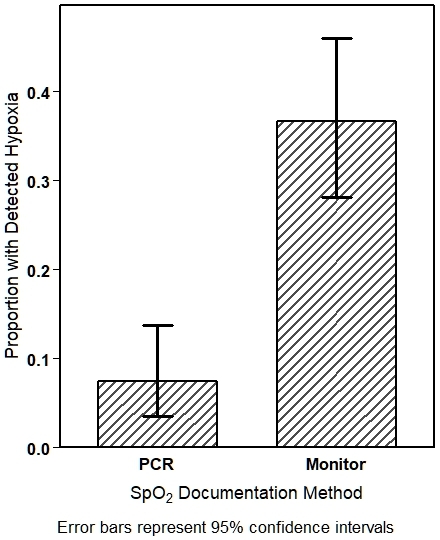Final ID: Su601
Missed Hypoxia in the Prehospital Care of Major Traumatic Brain Injury: Discrepancies Between Continuous Monitor Data and Clinical Documentation
Abstract Body: Background: It is well established that prehospital hypoxia dramatically increases mortality in Traumatic Brain Injury (TBI). Thus, in EMS TBI research, case ascertainment and risk adjustment are highly dependent upon documentation of in-field O2 saturation (SpO2). Objective: To compare the rate of hypoxia identified by EMS personnel and documented in EMS patient care records (PCR) versus the actual rate of hypoxia recorded by continuous, non-invasive monitoring in TBI.
Methods: A subset of major TBI cases (moderate/severe) from 5 EMS agencies reporting monitor data (Philips MRx™) in the EPIC EMS TBI Study (NIH 1R01NS071049) were evaluated (02/13-02/18). All monitor data available for post-hoc review were displayed and accessible to the providers during EMS care. We compared PCR documentation of hypoxia (SpO2<90%) to continuous monitor data in TBI patients (nasal canula O2, mask, basic or advanced airway). Statistic: exact McNemar’s test, α=0.05.
Results: 120 cases were included [med. age 50; IQR (23.8, 68); 65% male. Monitors recorded 44 hypoxic cases (36.7%; 95%CI 28.1, 45.9%). Only 8 (6.7%; 2.9, 12.7%) were documented in the PCR (p<0.0001; Figure). Three machine-detected hypoxia cases had no PCR-documented SpO2 at all.
Conclusions: The difference in PCR-documented and monitor-identified hypoxia was dramatic. The monitor data revealed a five-fold greater incidence of hypoxia than that documented by EMS providers. This may be partially explained by the continuous nature of pulse oximetry in the face of ongoing care responsibilities and scene distractions. The field environment may cause providers to miss low readings as they fluctuate moment-by-moment. These findings have major clinical implications. While some of the discrepancy between PCR reporting and monitor data might simply be failure to document hypoxia, the much more concerning implication is that many cases might be unrecognized and untreated. Furthermore, these findings have important implications for case ascertainment, confounding, and risk-adjustment in EMS TBI research. Whenever possible, quality improvement and research projects should utilize continuous non-invasive monitor data to identify and evaluate hypoxic patients in the setting of TBI. These findings may also have implications for identifying hypoxia in EMS patients with other critical conditions.
Methods: A subset of major TBI cases (moderate/severe) from 5 EMS agencies reporting monitor data (Philips MRx™) in the EPIC EMS TBI Study (NIH 1R01NS071049) were evaluated (02/13-02/18). All monitor data available for post-hoc review were displayed and accessible to the providers during EMS care. We compared PCR documentation of hypoxia (SpO2<90%) to continuous monitor data in TBI patients (nasal canula O2, mask, basic or advanced airway). Statistic: exact McNemar’s test, α=0.05.
Results: 120 cases were included [med. age 50; IQR (23.8, 68); 65% male. Monitors recorded 44 hypoxic cases (36.7%; 95%CI 28.1, 45.9%). Only 8 (6.7%; 2.9, 12.7%) were documented in the PCR (p<0.0001; Figure). Three machine-detected hypoxia cases had no PCR-documented SpO2 at all.
Conclusions: The difference in PCR-documented and monitor-identified hypoxia was dramatic. The monitor data revealed a five-fold greater incidence of hypoxia than that documented by EMS providers. This may be partially explained by the continuous nature of pulse oximetry in the face of ongoing care responsibilities and scene distractions. The field environment may cause providers to miss low readings as they fluctuate moment-by-moment. These findings have major clinical implications. While some of the discrepancy between PCR reporting and monitor data might simply be failure to document hypoxia, the much more concerning implication is that many cases might be unrecognized and untreated. Furthermore, these findings have important implications for case ascertainment, confounding, and risk-adjustment in EMS TBI research. Whenever possible, quality improvement and research projects should utilize continuous non-invasive monitor data to identify and evaluate hypoxic patients in the setting of TBI. These findings may also have implications for identifying hypoxia in EMS patients with other critical conditions.
More abstracts on this topic:
AI-Based ECG Denoising Improves Smartwatch ECG Interpretation
Liao Shun, Di Achille Paolo, Vakharia Tanay, Faranesh Tony, Shreibati Jacqueline, Poh Ming-zher
Chest compression synchronized ventilation is associated with improved oxygenation but also with increased incidence of pneumothoraces in an experimental CPR model.Kopra Jukka, Mehtonen Lassi, Laitinen Merja, Litonius Erik, Oestman Robert, Heinonen Juho, Skrifvars Markus, Pekkarinen Pirkka

